
Oblique fractures are a type of bone fracture that occurs when a bone is broken in an angled pattern. These fractures can be difficult to treat and can lead to long-term complications if not treated properly. Fortunately, there are a variety of approaches to treating oblique fractures that can help to ensure a successful recovery. This article will discuss the different approaches to treating oblique fractures, including the use of immobilization, surgery, and physical therapy. It will also provide information on the potential risks and benefits associated with each approach. By understanding the different treatment options available, patients can make an informed decision about the best course of action for their particular situation.
Exploring the Different Types of Oblique Fracture Treatment: A Comprehensive Guide
Oblique fractures are a type of fracture that occurs when a bone is broken in an angled pattern. These fractures can be difficult to treat, as they often require a combination of surgical and non-surgical treatments. In this guide, we will explore the different types of oblique fracture treatment and discuss the best approach for each.
Non-Surgical Treatment
Non-surgical treatment is the most common approach for treating oblique fractures. This type of treatment typically involves immobilizing the affected area with a cast or splint, as well as providing pain relief with medications. Physical therapy may also be recommended to help restore strength and range of motion.
Surgical Treatment
In some cases, surgery may be necessary to treat an oblique fracture. This type of treatment typically involves using metal plates, screws, and pins to hold the broken bone in place while it heals. Surgery may also be used to repair any damage to the surrounding tissue or ligaments.
Rehabilitation
Rehabilitation is an important part of oblique fracture treatment. This type of treatment typically involves physical therapy to help restore strength and range of motion. It may also involve occupational therapy to help the patient regain the ability to perform everyday activities.
Alternative Treatments
In some cases, alternative treatments may be used to treat oblique fractures. These treatments may include acupuncture, massage, and chiropractic care. While these treatments may provide some relief, they should not be used as a substitute for medical treatment.
No matter what type of oblique fracture treatment you choose, it is important to follow your doctor’s instructions and attend all follow-up appointments. With the right treatment plan, you can help ensure a successful recovery.
Understanding the Benefits of Physical Therapy for Oblique Fracture Treatment and Recovery
Physical therapy is an important part of the treatment and recovery process for those who have suffered an oblique fracture. Oblique fractures are a type of fracture that occurs when a bone is broken in a diagonal line. These fractures can be very painful and can cause a great deal of discomfort. Physical therapy can help to reduce pain, improve mobility, and speed up the healing process.
Physical therapy for oblique fracture treatment and recovery can help to reduce pain and swelling. Physical therapists can use a variety of techniques to reduce pain, including massage, stretching, and strengthening exercises. These techniques can help to reduce inflammation and improve circulation, which can help to reduce pain and swelling.
Physical therapy can also help to improve mobility. Physical therapists can use a variety of techniques to help improve range of motion and flexibility. These techniques can help to reduce stiffness and improve the ability to move the affected area. This can help to reduce the risk of further injury and improve overall function.
Finally, physical therapy can help to speed up the healing process. Physical therapists can use a variety of techniques to help promote healing, including ultrasound, electrical stimulation, and cold laser therapy. These techniques can help to reduce inflammation and promote the healing of the affected area.
Physical therapy is an important part of the treatment and recovery process for those who have suffered an oblique fracture. Physical therapy can help to reduce pain, improve mobility, and speed up the healing process. If you have suffered an oblique fracture, it is important to speak to your doctor about the benefits of physical therapy and how it can help you on your road to recovery.Oblique fractures can be a difficult injury to treat, but with the right approach, they can be healed successfully. The most important factor in successful treatment is to ensure that the fracture is properly aligned and stabilized. This can be done through a combination of immobilization, casting, and/or surgery. Additionally, physical therapy and rehabilitation can help to ensure that the patient regains full range of motion and strength in the affected area. With the right treatment plan, oblique fractures can be healed and the patient can return to their normal activities.